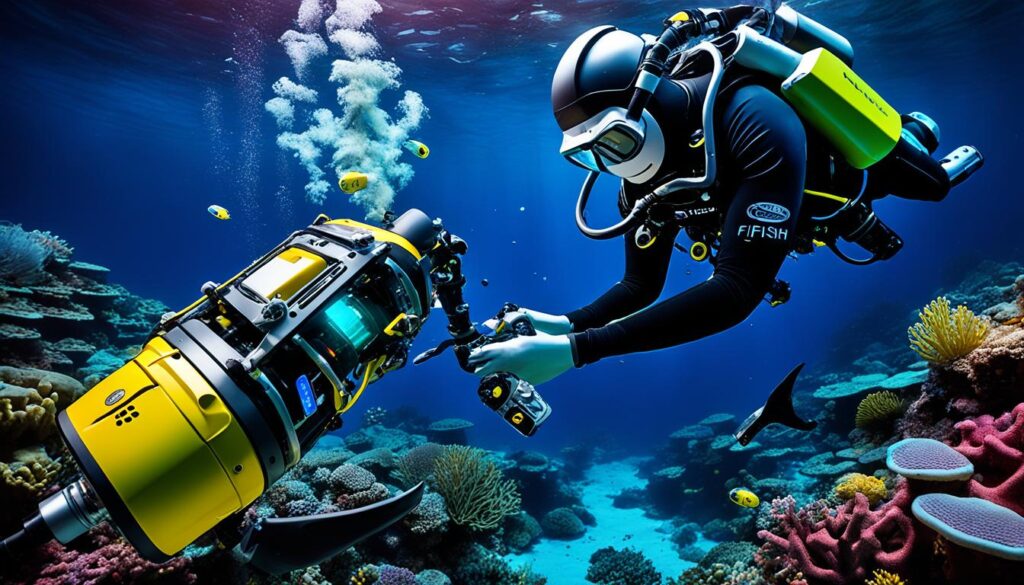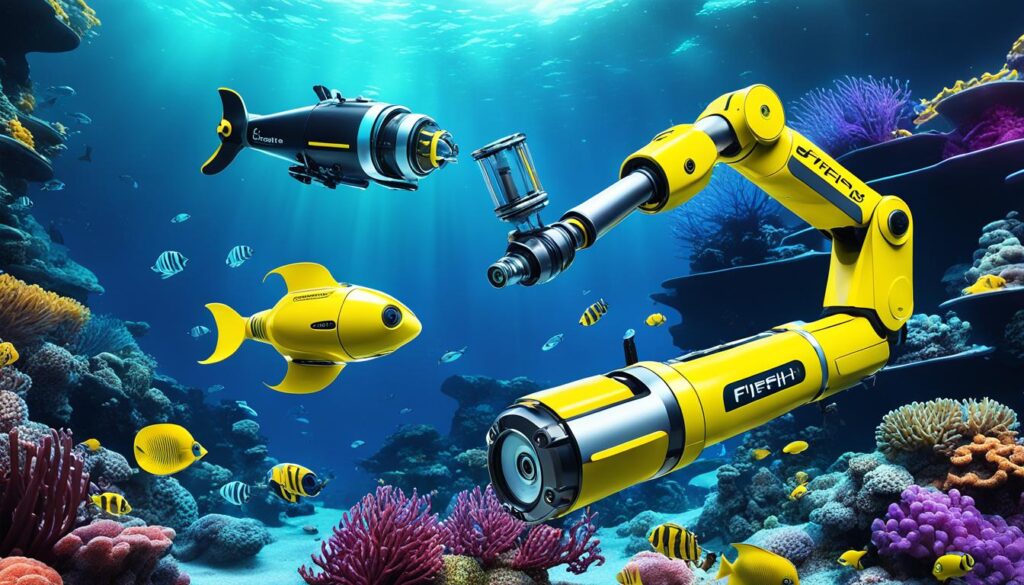The realm of underwater exploration and task execution has been revolutionized by the advent of underwater robotics, with the FIFISH V6s leading the charge. Its exceptional robotic arm is transforming how we interact with the subaqueous world, enabling precision and adaptability in an environment that has traditionally challenged human capabilities. This pinnacle of underwater innovation marks a significant milestone in the ongoing narrative of oceanic investigation, where the synthetic muscle of the robotic limb: FIFISH V6s is not only complementing but also revolutionizing human efforts beneath the waves.
Key Takeaways
- The FIFISH V6s represents a significant leap in underwater task management.
- Its robotic arm is at the forefront of revolutionizing underwater mechanics and operations.
- Advanced technology allows for unprecedented precision and versatility in the depths.
- This innovation offers safer alternatives for underwater exploration and research.
- With its introduction, human intervention in hazardous environments can be minimized.
Unpacking the FIFISH V6s Underwater Drone
As we delve into the realm of aquatic robotics, the FIFISH V6 underwater drone surfaces as a sterling example of cutting-edge technology. This exceptional remotely operated vehicle (ROV) is not only designed to endure the rigors of complex underwater tasks, but is also equipped with a versatile suite of tools that redefine the scope of marine operation.
The FIFISH V6s boasts a slew of features aimed at delivering unrivaled performance beneath the waves. Its high-definition camera captures the underwater world with stunning clarity, while the robust multi-directional robotic arm executes tasks with adept precision. Whether it’s intricate inspections or the collection of marine samples, the V6s stands ready to take on the challenge.
Steadily gliding through subaquatic landscapes, the FIFISH V6s undertakes adventures that were once exclusive to human divers. The drone offers a 360-degree field of view, unlocking panoramic vistas of the abyss. With its ability to reach profound depths, the V6s opens a new frontier for industries such as scientific research, underwater archaeology, and offshore energy, where thorough and periodic inspections are crucial.
- 360-degree field of view for comprehensive underwater imaging
- Advanced high-definition camera for detailed inspections
- Multi-directional robotic arm for diverse operational capabilities
- Capability to perform in challenging depths beyond human reach
- Revolutionizing underwater interventions across various sectors
The FIFISH V6s underwater drone encapsulates the progress of modern marine technology. It not only fulfills existing operational needs but also push the boundaries of what is conceivable in underwater exploration and industry application. The FIFISH V6s is more than a tool; it’s a harbinger of an underwater revolution, unfurling in the depths where the future of marine exploration and utility unfolds.
The Robotic Limb: FIFISH V6s’s Robotic Arm Revolutionizing Underwater Tasks
The emergence of the robotic limb: FIFISH V6s marks a transformative moment in robotic arm technology, ushering in a new era for oceanic exploration and intervention. This breakthrough apparatus is not merely an accessory but a pivotal tool that enhances the capacity to undertake a plethora of subsea operations with exceptional dexterity.
The precision-engineered appendage of the FIFISH V6s extends the boundaries of robotic arm revolutionizing efforts, supporting intricate tasks like archaeological research where meticulous handling and delicate maneuvers are essential. Simultaneously, the V6s arm robustly responds to industrial demands such as the laying and maintenance of subsea infrastructure, demonstrating a tight synergy between delicacy and strength.
| Task Type | Role of FIFISH V6s Robotic Arm | Traditional Method Limitations |
|---|---|---|
| Archaeological Excavation | Enables precise and non-intrusive artifact retrieval | Limited by human dexterity and access |
| Subsea Cable Maintenance | Delivers enhanced grip and manipulation for repairs | Requires complex diver operations or large ROVs |
| Environmental Monitoring | Performs delicate sampling without disturbing the habitat | Deploys bulky equipment with lower sensitivity |
The robotic limb: FIFISH V6s harbors the capability to modulate interaction with a wide range of materials and objects, boasting a design that integrates both sensitivity and power. It sets itself apart from prior technologies, which often had to sacrifice one for the sake of the other, making the V6s’s arm a pioneering force in underwater robotics.
- Articulated joints for multi-axis movements
- Adaptive grip control for handling variable object sizes
- High-torque motors to execute substantial tasks
- Feedback systems for real-time adjustments underwater
These functionalities reflect a significant leap forward from traditional approaches, and they catalyze operations that were previously deemed too challenging or perilous for direct human involvement. Therefore, the integration of the FIFISH V6s’s robotic arm into marine activities not only enhances operational efficiency but also prioritizes human safety.
Engineering Behind the FIFISH V6s Robotic Arm Technology
The prowess of robotic arm technology in underwater exploration has taken a significant leap forward with the FIFISH V6s. This marvel of engineering integrates next-gen capabilities to not only meet but surpass the stringent demands of aquatic operations. Beneath these advancements lies meticulous care in design, choice of materials, and harmonization with the V6s system, confirming its status as a paragon of underwater robotics.
Materials and Design
Constituting the foundation of the arm’s resilience is the selection of high-grade materials. Robust and designed to defy corrosion, these materials ensure the robotic arm withstands the harsh conditions and pressures of underwater environments. This commitment to quality in material choice underpins the V6s’s promise of durability and long-term service in the depths.
Control and Flexibility
The robotic appendage mirrors the complex movements of its human counterpart, boasting capabilities that include nuanced rotational maneuvers and varying grip strengths. This degree of control and flexibility elevates the precision of tasks performed, translating into an impressive array of underwater applications, making it a significant asset for any endeavor requiring a fine-tuned approach.
Integration with the V6s System
Integration with V6s is a pinnacle feature of this technologically advanced arm. The seamless interplay between the arm and the V6s’s operating system results in an intuitive experience for the operator. Every move made on the controls above the surface is replicated with astonishing fidelity in the aquatic theatre, displaying the elegant synergy at the heart of this technology.
Enhancing Underwater Exploration with the FIFISH V6s
The FIFISH V6s, equipped with a robust robotic arm, has significantly advanced the domain of underwater exploration. This sophisticated piece of underwater innovation has become an essential asset for marine professionals worldwide. The V6s’s versatility and high-performance capabilities enable detailed and sensitive operations far below the surface.

Marine biologists benefit from the V6s through the robotic arm’s ability to delicately gather samples from the ocean floor. Similarly, oceanographers can engage in thorough environmental monitoring, unlocking the mysteries held by the aquatic depths. Through its advanced camera systems paired with the robotic arm, the FIFISH V6s provides unparalleled visual assistance, allowing for the documentation and analysis of marine life with an exceptional level of detail.
Underwater cinematographers also find the FIFISH V6s a groundbreaking tool. It provides them the opportunity to capture stunning visuals in challenging underwater environments, thanks to its state-of-the-art lighting and camera technology. Whether it’s capturing the vibrant ecosystems of coral reefs or navigating the dark mysteries of a sunken ship, the V6s’s robotic arm acts as the perfect extension of human capability, rendering what was once thought impossible into a reality.
- Sample collection with precision
- Documenting underwater flora and fauna
- Environmental monitoring and data collection
- High-definition recording of geological formations
- Exploration of historical underwater sites and artifacts
The integration of the fifish v6s robotic arm has undoubtedly opened up new horizons for underwater professionals, allowing them to conduct complex tasks with improved safety and efficiency. These further democratize oceanic discovery, inviting more stakeholders to partake in the vital study and preservation of our underwater world.
Applications: Next-Gen Robotic Arms in Action
The advent of next-gen robotic arms marks a transformative era in underwater robotics, with innovative arms like the one on the FIFISH V6s revolutionizing the way we approach underwater tasks. These state-of-the-art tools are no longer confined to the realm of science fiction, but are actively shaping the present and future of subaqueous operations. Their applications range from underwater construction to environmental preservation, making them indispensable assets in the industry.
Here are just a few sectors where these sophisticated arms are currently making waves:
- Underwater infrastructure creation and repair
- Biological sampling and marine life studies
- Archaeological discoveries and artifact retrieval
- Subsea pipeline installation and maintenance
- Search and rescue missions in perilous underwater conditions
Across these diverse areas, the precision and versatility of robotic arms like the one equipped on the FIFISH V6s are crucial. They enable technicians to perform delicate and dangerous tasks remotely, effectively minimizing risks and expanding the range of achievable operations under the sea.
Utilizing next-gen robotic arms transforms our capabilities, allowing us to interact with underwater environments in ways that were once impossible. – An Industry Expert on Underwater Robotics
Below, we can see a comparison of underwater tasks enabled by this groundbreaking technology compared to traditional methods.
| Task | Traditional Method | With Next-Gen Robotic Arms |
|---|---|---|
| Pipe Assembly | Manual assembly by divers | Robotic arms perform assembly with higher precision |
| Welding | Highly skilled divers with specialized equipment | Remote welding with enhanced safety and accuracy |
| Coral Planting | Direct human interaction, which can be harmful | Delicate handling preserving marine ecosystems |
| Artifact Retrieval | Manual retrieval with potential for damage | Sensitive extraction preserving historical integrity |
| Search and Rescue | Risk-laden diver deployment | Fast, safe remote operations in hazardous conditions |
The unparalleled benefits of employing next-gen robotic arms such as the FIFISH V6s’s extend beyond mere functionality. They represent a groundswell shift towards smarter, safer, and more sustainable underwater intervention strategies.
The Role of the FIFISH V6s in Underwater Robotics
Delving into the world of underwater operations, the FIFISH V6s is more than a technological feat; it embodies the robotic arm revolutionizing how humans interact with the ocean’s depths. Standing at the precipice of innovation, this advanced remotely operated vehicle (ROV) shifts paradigms, making a significant leap from traditional subaquatic methodologies.

Comparing to Traditional Methods
The introduction of the FIFISH V6s represents a tidal shift in underwater robotics. Where once cumbersome and risk-laden diver missions were the norm, we now see a trend toward deploying sophisticated robots. These machines take on the dangerous and the impossible, tasks which previously tested human limits and exposed divers to unnecessary hazards. The FIFISH V6s, with its precision-crafted robotic arm, facilitates a new degree of safety and efficiency in underwater tasks.
Innovations in Safety and Efficiency
The cornerstone of the FIFISH V6s’s success lies in its innovative features which significantly enhance safety and operational efficiency. The robotic arm’s meticulous design allows for precise, controlled movements underwater—operations that no human diver could replicate without substantial risk. These innovations don’t just protect human operators; they streamline processes, reduce operational time, and conserve valuable resources, charting a course for sustainable underwater operations.
Ecosystem Impact Considerations
Moreover, the sustainable prowess of the FIFISH V6s takes into account the delicate nature of marine ecosystems. Operations that were once intrusive and possibly destructive can now be conducted with minimal impact. The ROV’s precision tools, including the revolutionary robotic arm, ensure that researchers and commercial operators can interact with the underwater environment in an environmentally responsible manner, thereby preserving the intricate balance of marine life.
The capabilities of the FIFISH V6s mark an essential chapter in the narrative of underwater robotics, reflecting a harmonious blend of technological prowess, safety considerations, and ecological consciousness.
Challenges and Future Developments in Robotic Arm Technology
The exploration and utilization of underwater environments remain at the cutting edge of innovation, with robotic arm technology playing a critical role. However, the path forward is fraught with challenges in underwater robotics that both hinder and inspire progress in this sophisticated field.
One of the principal hurdles faced by robotics engineers is the creation of mechanisms that can withstand the intense pressure of deep-sea environments. This challenge has given impetus to research in materials science and engineering design, both of which are integral to future developments in robotic arm technology. The key is finding a synergy between resilience and functionality, ensuring that the cutting-edge arms can operate at great depths without succumbing to the ocean’s crush.
Another challenge is crafting robotic systems that can operate with high energy efficiency. Pioneering underwater missions often require prolonged periods of autonomy, pushing the boundaries for longer battery life and innovative power solutions. Such advancements are essential for tasks ranging from archaeological discoveries to the monitoring of ocean currents and marine life patterns.
| Challenges | Future Prospects |
|---|---|
| Deep-sea pressure resilience | Materials and designs for extreme depths |
| Energy efficiency | Advancements in energy storage and management |
| Autonomous operations | Integration of AI for decision-making and task execution |
The evolution of autonomous functionality is equally critical. Future underwater robotic systems are expected to boast enhanced AI capabilities, allowing them to perform complex tasks and make real-time decisions without human intervention. This push towards autonomy not only expands the potential applications of these machines but also offers safer options for operations in hazardous conditions.
The intersection of these challenges with continuous innovation promises to unlock an exciting array of capabilities in underwater robotics. As technology matures, the horizon of what these robotic arms can achieve in the uncharted depths of our oceans broadens, heralding a future of boundless exploration and discovery.
Conclusion
The culmination of this exploration into the FIFISH V6s’s capabilities clearly indicates a transformative period in underwater robotics. The integration of advanced robotic arm technology within the V6s has not just been an incremental update; it has been a monumental stride that redefines human interaction with marine environments. The versatility and efficiency that this innovation introduces allow for complex underwater tasks to be accomplished with unprecedented precision and safety.
Summary of the FIFISH V6s Advancements
Summarizing the achievements of the FIFISH V6s, it’s evident that this remotely operated vehicle has become a pivotal tool in enhancing our abilities to conduct underwater operations. The robotic arm, with its nimble articulation and robust functionality, propels a myriad of applications from scientific research to infrastructure maintenance. This leap in technology exemplifies the sheer potential of underwater robotic innovation, setting a new benchmark for what’s achievable beneath the surface.
Implications for Industry and Research
The implications for industry and research are significant. With the integration of such technology, various sectors, including oceanography, marine biology, archeology, and offshore energy, now have at their disposal a solution that promises not only to revolutionize processes but also to ensure the safety of human divers, and the preservation of undersea life. It stands as an exemplar of progress, showcasing how underwater robotics can guide human expertise to new depths.
Final Thoughts on Underwater Robotic Innovation
As the narrative of the FIFISH V6s continues to unfold, it heralds a future where technological symbiosis with our oceans is not just a dream but an accessible reality. Embracing underwater robotic innovation means not only unlocking the secrets of the deep but doing so in a manner that harmonizes with the ecological tapestries of our waters. The vast potential of these burgeoning technologies invites us to envision an era of discovery and progress that flows as deep as the very oceans they navigate.






